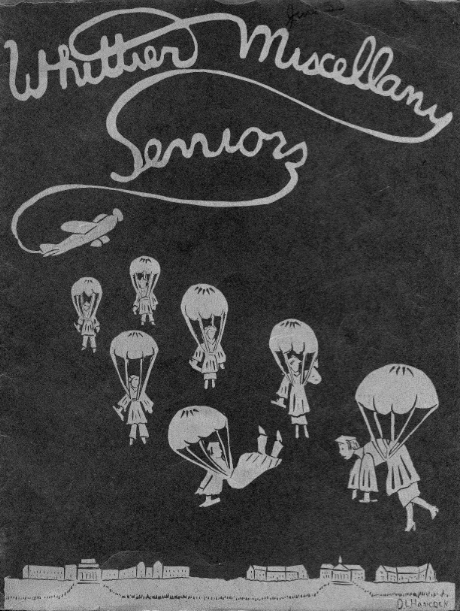From 1895-2015, Whittier Celebrates 120th Anniversary
February 2015
Since the original publication started in 1895, 2015 marks the 120th year anniversary of the Whittier. The Whittier is the oldest high school newspaper in Delaware, probably because Wilmington Friends is the oldest high school in Delaware. Unlike the large student paper the Whittier comprises to date, the Whittier evolved from the Whittier Literary Society. The Whittier Literary Society was formed in 1884 after John Greenleaf Whittier, a beloved Quaker poet and abolitionist of the 19th century, gave his permission for the publication to use his name. The Whittier Literary Society composed hand-written works for 11 years until 1895, which marked the publishing of the first official Whittier documents. In order to get more information about the evolution of the Whittier, we sat down with Terry Maguire, former Friends teacher and Whittier advisor and current writer for Quaker Matters.
Up until the late 1940s, the Whittier Literary Society published primarily a literary magazine three times a year with student artwork, short stories, alumni news, and sports reports. The literary magazine staff was quite different than the staff of the current Whittier. The Whittier Literary Society was not exclusively a high school publication. The literary magazine included original work from both middle school and high school students, but it was fairly competitive to get work published. Jane Hayden Frelick, Editor-in-chief of the literary magazine in 1936-37, the last year school year at the old school, shared that it was a “real honor” to have your work selected.
The third issue of the literary magazine, called the Senior Issue, also served as the Wilmington Friends yearbook. The Senior Issue featured portraits of the Senior class and senior superlatives. There were also pictures of athletic teams. Underneath team pictures, captions would only identify students by their last name. Similar to the current Whittier’s Awards Issue, the Senior Issue would feature articles on the recipients of awards.
There was an incredible range of creative liberty that the literary magazine offered to students. Some of our favorite titles we found while exploring archives of the literary magazine were: “Manners in the Classroom”, “Sleeping Outdoors” , and “How to Be a Lady”. The Whittier Literary society transitioned away from literary and fiction stories and more towards stories that would comprise a newspaper when the Prism Magazine was created in 1981; fostering a separate place for creative writers at Friends.
The Whittier throughout time has been an institution where news about the school has been published. In 1937, Friends moved from its original location in Wilmington to Alapocas. In the months leading up to the transition, articles, cartoons, and drawings were published dedicating the old building, and informing the community about the new building. When the theater was built in the 1950s, there were articles published with pictures of the construction and the blueprints of the new facilities. Articles on the construction of the theater captured the astonishment of the community. This new theater would cost an estimated 250,000 dollars, an impressive amount of money at the time but seems rather measly compared to the 9 million dollar construction of our current theater.
The evolution of technology was another fascinating factor that shaped both the Whittier’s visual appeal and the responsibilities of the editors. Until 1985, the Whittier Literary Society relied on entirely hand-written writing. After the transition to typewriters, laying out the literary magazine, which later evolved into a paper, became almost like solving a puzzle. Editors had to physically cut and paste most lines, sometimes using Exacto knives, and make sure each line matched up with each other. This was a rather tedious and meticulous task for editors to take on. When a line from an article went missing, editors would check everywhere to find the paper; even the soles of their shoes. It was not until the mid 80s, that the Whittier transitioned to word-processing.
Photography marked another challenge for the paper. The Senior portraits featured in the literary magazine Senior Issue were taken professionally. To produce other pictures, editors worked in dark rooms developing films and working with the inks, but the photography was still far from impressive considering today’s standards. The first years of digitized photos still lacked quality and it was not until the turn of the 21st century when photos became more distinguished.
The Whittier used to be more involved in school life outside of just a literary publication. The Whittier Literary Society had a history of putting on the school’s play every March, and the staff of the Whittier would take on the roles of actors. The Whittier also organized an annual dance, starting in 1909 when dancing was first allowed at Friends as long as it was “modest and appropriate.”
While the transition from a literary magazine to the newspaper that we know today marks a significant change in the evolution of the Whittier, there are still many discernible features that make the Whittier and its editorial process in the 1980s, during the time Maguire was the advisor, markedly different than the Whittier today. Today, editorials are generally given to the editors-in-chief to write, and possibly a few selected guest writers. The decision over what the guest writers will write about is made by the editors-in-chief. In the 1980s, lots of students wrote opinion articles and signed their names, but the whole editorial staff had a say in what the “staff editorials”, or editorials written by members of the editorial staff, were written about. To write a staff editorial was one of the highest honors a writer could receive while being on the staff of Whittier. Because of this, it was not uncommon for the process of choosing editorials to take a couple of sessions. These sessions would be filled with debate, because everyone had to agree about what the article would be written about. In one example in 1982, a writer wanted to write an editorial about the conflict between Israel and Palestine and how Israel was responsible for an assault on refugees that they might have been able to prevent. It took seven sessions to agree on what the editorial would be about, and how it would be structured. All of the staff editorials were unsigned because they were the agreed-upon thoughts of the Whittier staff as a whole.
Another large difference between the Whittier 30 years ago, and the Whittier today was that Whittier used to be an actual class, not just a club that one receives a pass fail grade for. At the end of the semester, the advisor at the time would write long and detailed reports, similar to ones that students receive at the end of a semester for regular classes, evaluating their writing performance and contribution to the paper. Whittier also had a scheduled time to meet two times during the six day cycle, creating a more serious and structured environment for the newspaper.
The Whittier has gone through many transitions in format throughout its tenure at Friends. From an unpublished version leading up to 1895, to a literary magazine, to a full page spread in the 1950s, to handwritten articles, and finally to the introduction of word processing. All of these versions of the Whittier have been print versions. Last year, in 2014, the Whittier officially launched its online web site, www.wfswhittier.net. This web site houses mostly recent articles, as far back as March 2014, published by the Whittier in the print version as well. The online newspaper raises the question about if print is becoming obsolete. Will Whittier always have its classic print newspaper? Or will one day, fifty years from now, will two editor-in-chiefs be sitting with a past Whittier advisor and reminiscing on the days of print journalism? Only time will tell, but as Maguire remarks, “As long as it is clear, organized and accessible, can Whittier continue its long tradition as a quality student-run newspaper.”
It is clear that the Whittier has undergone major changes since its first official publication in 1895. These changes have ranged from the form of the Whittier, to the structure of the Whittier, to the running of the Whittier. But throughout these 120 years worth of changes, some things have not changed. One of these things is a concern for good writing, starting around 1886, before the Whittier was first officially published. Another is an awareness of the world outside of the school. If one is to look through the archives of the Whittier, it is common to see something about international travel or international instances. This theme of internationalism plays into the world view that Friends as a school has tried to have since its founding in 1748. Overall though, Whittier has continued to publish quality stories because of its Quaker roots and philosophies. According to Maguire, “Quakers have been interested in a literate, educated society from the earliest times. Education for men and women is important – and the school has certainly been dedicated towards the continuation of it.”




































